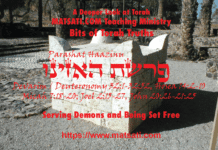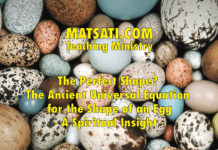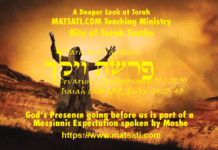This weeks reading is from Parsahat Emor (Vayikra / Leviticus 21:1-24:23) the Lord speaks to the sons of Aaron to be careful not to defile themselves by touching a dead person among his people. The Mitzvah not to shave making baldness on our heads is given, and not to round the edges of our beards, or make cuts in our flesh. The Priests are not to take a woman who has profaned herself as a prostitute or to take a woman who is divorced from her husband (21:7). The priest that is anointed with oil shall not tear his cloths, uncover his head, or defile himself by a dead person, not even his nearest relative (21:11). The person who has a defect, who is lame, blind, or disfigured face or deformed limb, broken foot or hand, hunchback or dwarf, defect in his eye or skin malady, or crushed testicles, no one who has these defects in their bodies from the descendents of Aaron are to come near to offer the sacrifices before the Lord (21:18-21). Additional commands are given on who may and may not eat of the holy gifts. The entering into the sanctuary in uncleanness and eating of the food that is given to the Priests results in the bearing of the guilt of sin. We are told that the animals brought for an offering before the Lord are to be perfect and without defect (22:18-25). The Lord then declares His Moedim (Appointed times) and the scriptures declare in these appointed times that God is sanctified. The first Moedim is to work six days and rest on the seventh, the Shabbat day rest (23:3), the second festival is Pesach (Passover) (23:5) and the feast of Unleavened bread (23:6), and then follows the Festival of Shavuot (Pentecost) (23:10-13). The Feast of trumpets (23:26-32) and Succot (Tabernacles) are also mentioned. This week’s reading also states that 24:22 ‘There shall be one standard for you; it shall be for the stranger as well as the native, for I am the Lord your God.’‘ (NASB) Reading through the Scriptures from Vayikra / Leviticus 23:9-13, it is interesting to note that these Scriptures are rarely mentioned. What is significant of this festival?
ספר ויקרא פרק כג
ט וַיְדַבֵּר יְהוָֹה אֶל-מֹשֶׁה לֵּאמֹר: י דַּבֵּר אֶל-בְּנֵי יִשְֹרָאֵל וְאָמַרְתָּ אֲלֵהֶם כִּי-תָבֹאוּ אֶל-הָאָרֶץ אֲשֶׁר אֲנִי נֹתֵן לָכֶם וּקְצַרְתֶּם אֶת-קְצִירָהּ וַהֲבֵאתֶם אֶת-עֹמֶר רֵאשִׁית קְצִירְכֶם אֶל-הַכֹּהֵן: יא וְהֵנִיף אֶת-הָעֹמֶר לִפְנֵי יְהוָֹה לִרְצֹנְכֶם מִמָּחֳרַת הַשַּׁבָּת יְנִיפֶנּוּ הַכֹּהֵן: יב וַעֲשִֹיתֶם בְּיוֹם הֲנִיפְכֶם אֶת-הָעֹמֶר כֶּבֶשֹ תָּמִים בֶּן-שְׁנָתוֹ לְעֹלָה לַיהוָֹה: יג וּמִנְחָתוֹ שְׁנֵי עֶשְֹרֹנִים סֹלֶת בְּלוּלָה בַשֶּׁמֶן אִשֶּׁה לַיהוָֹה רֵיחַ נִיחֹחַ וְנִסְכֹּה יַיִן רְבִיעִת הַהִין:Vayikra / Leviticus 23:9-13
23:9 Then the Lord spoke to Moses, saying, 23:10 ‘Speak to the sons of Israel and say to them, ‘When you enter the land which I am going to give to you and reap its harvest, then you shall bring in the sheaf of the first fruits of your harvest to the priest. 23:11 ‘He shall wave the sheaf before the Lord for you to be accepted; on the day after the sabbath the priest shall wave it. 23:12 ‘Now on the day when you wave the sheaf, you shall offer a male lamb one year old without defect for a burnt offering to the Lord. 23:13 ‘Its grain offering shall then be two-tenths of an ephah of fine flour mixed with oil, an offering by fire to the Lord for a soothing aroma, with its drink offering, a fourth of a hin of wine. (NASB)
In Vayikra / Leviticus 23:9-13, we read the Lord telling Moshe to speak to the people saying י דַּבֵּר אֶל-בְּנֵי יִשְֹרָאֵל וְאָמַרְתָּ אֲלֵהֶם כִּי-תָבֹאוּ אֶל-הָאָרֶץ אֲשֶׁר אֲנִי נֹתֵן לָכֶם וּקְצַרְתֶּם אֶת-קְצִירָהּ וַהֲבֵאתֶם אֶת-עֹמֶר רֵאשִׁית קְצִירְכֶם אֶל-הַכֹּהֵן: 23:10 ‘Speak to the sons of Israel and say to them, ‘When you enter the land which I am going to give to you and reap its harvest, then you shall bring in the sheaf of the first fruits of your harvest to the priest. (NASB) Here Moshe is explaining to the people that they need to bring the sheaf of the first fruits of their harvest to the priest. According to the Scriptures, the festival of Shavuot (Pentacost) is also known as the first day on which individuals could bring the Bikkurim (first fruits) to the Temple in Jerusalem (see Mishnah Bikkurim 1:3). The Bikkurim were brought from seven species of the Land of Israel: wheat, barley, grapes, figs, pomegranates, olives, and dates (Devarim / Deuteronomy 8:8). The festival of Shavuot is very significant since this was the day on which the Torah was revealed by God to Israel at the Mountain of Sinai and also the time-frame in history when the Holy Spirit was given to the disciples in Jerusalem (see Acts 2). Shavuot is also connected to the season of the grain harvest in Israel. In ancient times, the grain harvest lasted seven weeks and was a season of gladness (see Devarim / Deuteronomy 16:9-11, Jeremiah 5:24, Isaiah 9:2). Interestingly enough, this celebration begins with the harvesting of barley during Passover marking the beginning of the counting of the omer, and ended with the harvesting of the wheat during Shavuot. In other words, on this day the priest would wave a sheaf (omer) of green barley of the new harvest before the Lord as a symbolic gesture of dedicating it to Him. In addition to this, a male lamb was then sacrificed as a burnt offering to the Lord (an Olah Korban), along with a minchah (grain offering of unleavened read mixed with oil) and wine (Vayikra / Leviticus 23:13). Studying the text, it is remarkable that on this day a defect free male lamb was required to be offered along with bread and wine, the very symbols Yeshua used to direct our attention to His sacrifice upon the cross.
The significance of the festival that few people speak about is regarding the chronology surrounding Yeshua’s death, burial, and resurrection. Note also that a Hebrew day begins in the evening the prior night. The chronology goes something like this, the evening of Nisan 14, Yeshua had an early Seder, Wednesday night, and the Day time of Nisan 14 was the preparation day for Passover (see Luke 23:54 and Mark 15:42). The night of the Seder (Wednesday night) Yeshua and his disciples went out to the mount of olives to pray and he was arrested. The trial and crucifixion come Thursday morning, and by Thursday afternoon, at the same time the Pesach Korban (the Passover Lamb) was sacrificed in the Temple, Yeshua died. Nisan 15, the High Shabbat of Pesach begins. Nisan 16, the evening is the Erev Shabbat services. That day during Nisan 16, was the waving of the omer, the sheaf of barley before the Lord. Yeshua was resurrected some time prior to sunrise in Sunday. Nisan 17, during the day time (early morning) the women brought the spices to the tomb to treat the body of Yeshua and they find him in the garden risen. It is also interesting to note that based on this Chronology, Yeshua was in the grave 3 days and 3 nights and He did not raise on Sunday morning as is taught today. Sunrise services are based upon a tradition passed down from the fertility religions of the neighboring nations and adaptation by the Roman Catholic Church.
In addition to these things, the Apostle Paul links the waving of the Omer in the Temple in Jerusalem and the resurrection of Yeshua according to 1 Corinthians 15:20-23.
1 Corinthians 15:20-23
15:20 But now Christ has been raised from the dead, the first fruits of those who are asleep. 15:21 For since by a man came death, by a man also came the resurrection of the dead. 15:22 For as in Adam all die, so also in Christ all will be made alive. 15:23 But each in his own order: Christ the first fruits, after that those who are Christ’s at His coming, (NASB)
Paul clearly is drawing a parallel to the first fruits and the waving of the Omer. Additional references include Yeshua being the first begotten of the Father (Hebrews 1:6), the firstborn of Creation (Colossians 1:15-16), the first begotten of the dead (Revelation 1:5), and James 1:18 states 1:18 In the exercise of His will He brought us forth by the word of truth, so that we would be a kind of first fruits among His creatures. (NASB) The resurrection of the Messiah Yeshua demonstrates that He was accepted by God as a sacrifice for our sins. When our Father raised Yeshua from the dead, He confirmed the triumph and majesty of Yeshua as King of kings and Lord of Lords. Our pardon is contained within Yeshua’s payment for our sins! Praise the Lord God Almighty for such a wonderful Salvation! Amen! BTT_Parashat Emor-2014








